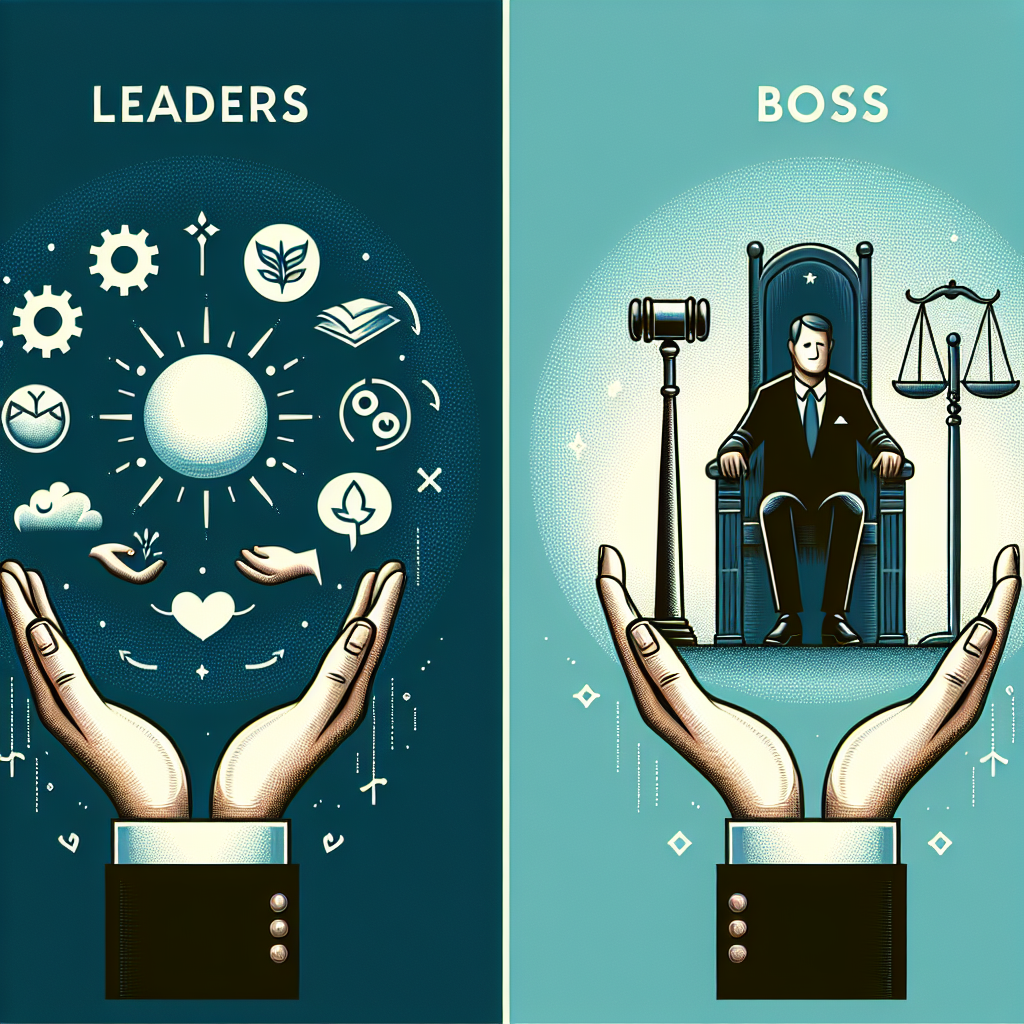In the world of management and supervision, there exists a fundamental distinction between a leader and a boss. While the terms are often used interchangeably, they possess distinct characteristics and approaches towards their teams. A leader is someone who inspires, motivates, and guides their subordinates towards a shared vision, fostering a sense of unity and collaboration. On the other hand, a boss may simply exercise authority, focusing solely on task completion without factoring in the well-being and growth of their employees. Understanding this distinction is crucial in creating a positive and productive work environment, where individuals feel valued and empowered.

Definition of a Leader and a Boss
Leader vs Boss
A leader and a boss may seem like similar terms, as they both involve a person in a position of authority within an organization. However, there are significant differences between the two. A leader is someone who guides and inspires their team to reach their full potential. They focus on building relationships, fostering collaboration, and empowering their employees. On the other hand, a boss is someone who primarily focuses on giving orders and ensuring that tasks are completed. They tend to rely more on their authority and control to get things done.
Other Words for Boss
While the term “boss” is commonly used to refer to someone in a position of authority, there are other synonymous terms that can be used. Some of these words include manager, supervisor, director, chief, and head. These terms all imply a certain level of authority and responsibility within an organization.
Difference between a Leader and a Boss
The key difference between a leader and a boss lies in their approach to managing and interacting with their team. A leader focuses on inspiring, motivating, and empowering their employees. They encourage personal and professional growth, foster a positive work environment, and prioritize the well-being of their team members. On the other hand, a boss tends to rely more on their authority and control to manage their team. They may be more focused on achieving tasks and meeting goals without necessarily prioritizing the growth and development of their employees.
Qualities and Characteristics
Traits of a Leader
Leaders possess several key traits that set them apart from a boss. These traits include empathy, effective communication skills, adaptability, and the ability to inspire and motivate others. Leaders listen to their team members, value their opinions, and create an inclusive and collaborative environment. They lead by example, are accountable for their actions, and encourage creativity and innovation within their team.
Traits of a Boss
While leaders focus on building relationships and inspiring their team, a boss may possess different traits. Bosses may be more authoritative, task-oriented, and may prioritize the completion of tasks over employee well-being. While they may be knowledgeable and experienced, some bosses may lack empathy and effective communication skills. They may also exhibit a more rigid leadership style and may be less open to feedback and new ideas.
Approach to Work and Team
Leadership Approach
Leaders approach work and their team with a collaborative mindset. They involve their team members in decision-making processes, seek input and ideas, and encourage open communication. They create an environment where everyone feels valued and empowered to contribute their best work. Leaders believe in building strong relationships and establishing trust with their team, which leads to a more engaged and motivated workforce.
Management Approach
In contrast, managers may have a more directive approach to work and their team. They ensure that tasks are completed efficiently, prioritize productivity, and may rely on more established processes and procedures. While managers provide direction and guidance, their approach may be less collaborative and may involve a more hierarchical structure. They may focus more on monitoring performance and meeting targets, rather than fostering a sense of ownership and empowerment among their team.
Motivational Style
Leadership Motivation
Leadership motivation centers around empowering and inspiring individuals to reach their full potential. Leaders build meaningful connections with their team members, understand their aspirations, and provide support and resources to help them achieve their goals. They recognize and reward achievements, and create a work environment that encourages personal and professional growth. By motivating individuals intrinsically, leaders foster a long-lasting commitment and enthusiasm within their team.
Management Motivation
Managers, on the other hand, often use a more structured and extrinsic motivational style. They may focus on tangible rewards, such as bonuses or promotions, to incentivize performance. While this can be effective in driving short-term results, it may not necessarily foster long-term employee engagement and satisfaction. Managers may also rely more on performance evaluations and disciplinary measures to motivate their team, and may not prioritize individual aspirations and growth as much as leaders do.

Communication Style
Leadership Communication
Effective communication is a vital skill for leaders. They actively listen to their team members, seek clarification, and provide constructive feedback. Leaders communicate transparently, openly sharing information and conveying their vision and goals clearly. They promote a culture of open dialogue, encourage diverse perspectives, and ensure that every team member feels heard and valued. By fostering effective communication, leaders build trust and reduce misunderstandings within their team.
Management Communication
Managers also communicate with their team members, but their approach may be more directive and task-oriented. They may prioritize clarity and efficiency, providing specific instructions and deadlines to ensure tasks are completed on time. While managers may still value feedback and open communication, their primary focus is on delivering instructions and information necessary for the completion of tasks. This may leave less room for dialogue and exploration of different perspectives.
Decision-Making Abilities
Leadership Decision-Making
Leadership decision-making involves a more inclusive and collaborative approach. Leaders actively involve their team members in decision-making processes, seeking input and feedback, and considering different perspectives. This approach not only encourages teamwork but also brings diverse insights to the table, resulting in enhanced decision-making. Leaders are open to challenging the status quo, taking calculated risks, and considering long-term consequences. They prioritize the well-being and growth of their team when making decisions.
Management Decision-Making
Managers make decisions based on their authority and expertise. They may rely on their experience, established protocols, and the established hierarchy to make decisions efficiently. Managers focus on meeting objectives and may be more concerned with immediate outcomes rather than the long-term impact. While managers may consult with their team members, their decision-making process may not be as inclusive or collaborative as that of leaders. They aim to ensure that tasks are completed efficiently and effectively.

Impact on Employee Satisfaction and Engagement
Leadership Impact
Leadership style has a significant impact on employee satisfaction and engagement. A leader who values and supports their team members creates a positive work environment where employees feel appreciated and motivated. When leaders inspire and empower their team, employees are more likely to feel a sense of purpose, job satisfaction, and commitment to their work. This results in higher levels of engagement, lower turnover rates, and increased productivity.
Management Impact
In contrast, the management style of a boss may have a different impact on employee satisfaction and engagement. If a boss focuses more on tasks and results rather than employee well-being, employees may feel undervalued and disengaged. A management style that lacks empathy and fails to provide support and recognition can lead to a negative work environment. This can result in decreased employee morale, increased turnover rates, and reduced productivity.
Long-Term Success and Growth
Leadership Success
Leadership style can contribute to long-term success and growth for both individuals and organizations. A leader who nurtures and develops their team members builds a strong and capable workforce. By empowering individuals to take on challenges and explore new opportunities, leaders foster continuous learning and professional growth. This not only benefits individual career development but also enhances the overall success and growth of the organization.
Management Success
While managers are responsible for executing tasks and achieving goals, their focus may be more on short-term success rather than long-term growth. Managers ensure that processes run smoothly, targets are met, and tasks are completed efficiently. However, their role may be more operational and task-focused, limiting their impact on long-term strategic success and growth. To ensure sustainable growth, organizations need a balance between effective management and visionary leadership.

Impact on Organizational Culture
Leadership Culture
Leaders play a crucial role in shaping organizational culture. A leader who prioritizes collaboration, transparency, and open communication sets the tone for a positive and inclusive work environment. With a strong emphasis on teamwork, trust, and respect, leaders foster a culture of innovation, creativity, and continuous improvement. They inspire a shared vision and align their team towards a common goal, creating a sense of purpose and unity within the organization.
Management Culture
The management style of bosses can also shape organizational culture but in a different way. If managers adopt a more directive and hierarchical approach, it may lead to a culture that values compliance and conformity over innovation and collaboration. Management-focused cultures may result in employees feeling less empowered, less motivated, and less likely to take initiative. This can hinder creativity, limit employee engagement, and impede the organization’s ability to adapt to change.
Development and Growth Opportunities
Leadership Development
Leadership development programs are essential for individuals aspiring to become effective leaders. These programs focus on enhancing leadership skills such as communication, emotional intelligence, and strategic thinking. They provide opportunities for self-reflection, learning from experienced leaders, and practicing leadership techniques. By investing in leadership development, organizations can groom future leaders who will drive innovation and growth.
Management Development
Management development programs also hold great value in organizations. These programs concentrate on developing managerial skills such as decision-making, problem-solving, and performance management. Managers benefit from learning new techniques and tools to enhance their operational effectiveness. By investing in management development, organizations can ensure that managers are equipped with the skills needed to execute tasks efficiently and support their teams effectively.
In conclusion, the distinction between a leader and a boss is significant. While both play important roles within organizations, leaders focus on inspiring, empowering, and fostering a positive work environment. They prioritize the well-being and growth of their team members, encourage collaboration, and drive innovation. In contrast, bosses may be more task-oriented and focused on achieving immediate results. Understanding the qualities, approaches, and impacts of both leadership and management styles can help organizations cultivate an environment that fosters employee satisfaction, engagement, and long-term success.

